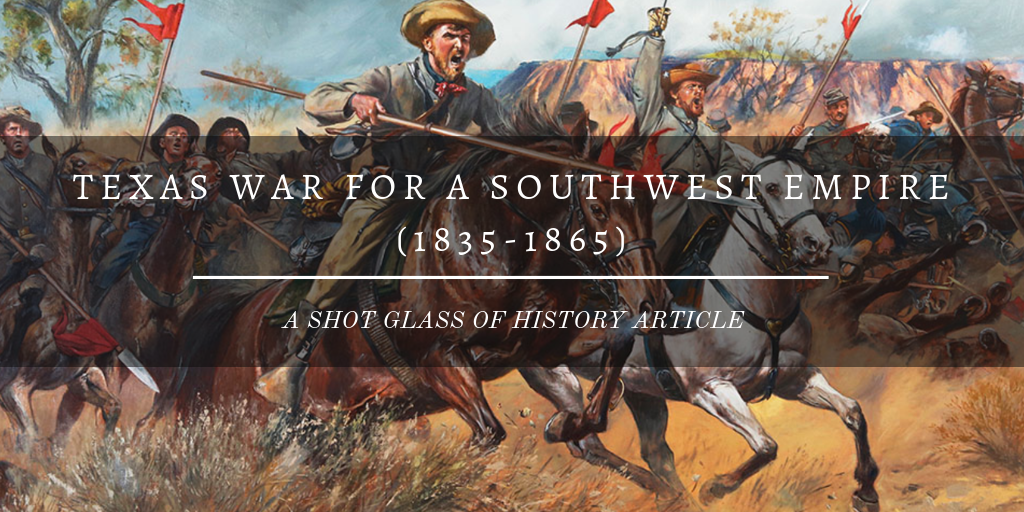Blood & Treasure: Confederate Empire in the Southwest
BY DONALD S. FRAZIER
TEXAS A&M UNIVERSITY PRESS, 376 PAGES, $14.75
–
In 1860 when the Confederacy attempted to become an independent, slaveholding republic with dreams of imperial expansion, they were following in the footsteps of a previous American republic with the same goals. For ten years, from 1835-1845, Texas had held this same vision before joining the Union, and then later the Confederacy. Donald Frazier’s work, Blood & Treasure: Confederate Empire in the Southwest, recounts the stirring tale of the Texan and Southern dreams of a southwest empire, and their wars to achieve it.
1800-1835
America had always had a dream of building what Jefferson described as an “Empire of Liberty”: a united, American Republic stretching from shore to shore and pole to pole. While the British managed to soundly repulse U.S. territorial expansion northwards into Canada during both the Revolutionary War and the War of 1812, the U.S. had better success in the west and south. By the antebellum period U.S. territorial acquisitions included Spanish Florida and French Louisiana, with Mexico next on the list.
Mexican possessions were particularly attractive to Southerners who dominated America’s foreign policy throughout the antebellum period.1 The struggle for political power in Washington during this time largely focused on controlling which political party the newly formed frontier states would align with upon entry into the Union. Since the Missouri Compromise of 1820 meant that only states south of the 36°30’ latitude would be admitted as slave states, Southern expansionists focused on trying to acquire the Caribbean, South America, Central America, and the American southwest. Fortunately for American expansionists, Mexico was openly encouraging immigration. Entrepreneurial and imperially minded Southerners flocked to Mexico’s promise of Texan land, and then led the drive for independence from the country that had invited them.
1835-1845

Once Texas achieved independence it quickly began to flex its expansionist muscles, laying claim with little justification to vast swaths of Mexican land along the entire stretch of the Rio Grande, while its politicians also openly pushed for territory as far west as the Sea of Cortez. With this end in mind they established their capital at Austin, farther inland in the west than towards the more heavily populated regions of Texas around the Gulf of Mexico.
During this time United States remained largely eager to avoid a war with Mexico, and refused to annex Texas while Texan independence was still in dispute. However, they had no problem encouraging Texan wars, and Andrew Jackson eagerly encouraged Texas to militarily follow through with its claims to California. Starting in 1841, Texas attempted multiple invasions of the Santa Fe region, but without success.
1845-1860
Unable to acquire their territorial goals as an independent republic, Texas managed to get the United States to annex them by threatening a British alliance. President Polk, himself an expansionist Southerner with designs on California, eagerly threw aside his predecessor’s concerns and brought Texas in as the 28th state in 1845. 2
U.S. and Mexican troops soon clashed in the disputed lands along the Rio Grande, sparking the Mexican-American War. The U.S. handily won the war, and in the resulting treaty of Hidalgo-Guadeloupe, the U.S. acquired 525,000 square miles of Mexican territory, including the territories of New Mexico and California, which Southerners hoped to incorporate into the U.S. as slave states, bolstering their representation in Washington.
However, Texas still retained their old land claims, and began to officially take control over the territory of New Mexico in March, 1848. Texas officials sent to Santa Fe were shocked and angered then to discover that federal troops stationed at Santa Fe refused to allow them to assume governance, and that Washington had no intent to grant Texas any part of the New Mexico territory. Feeling that Washington had betrayed them, the Texas government determined to press its claims and prevent New Mexico from gaining statehood, even by force if necessary. In the words of the Austin State Gazette: “We must protect our rights by that last resort of an injured people—the force of arms” (Frazier, Blood & Treasure, p. 9).
Fellow slave-states warmly expressed their support for Texas’ military resistance. Senator Alexander H. Stephens of Georgia, soon to be Vice-President of the Confederacy publicly warned: “The first Federal gun that shall be fired against the people of Texas . . . Will be the signal for freemen from Delaware to the Rio Grande to rally to the rescue” (p. 9).
In the face of these threats, President Zachary Taylor began moving additional U.S. troops into New Mexico. Meanwhile, in August of 1850 the Texas senate debated a bill to authorize sending three thousand Texas troops into Worth and Santa Fe to put down the “rebellion.” The crisis was narrowly averted by President Taylor’s death. No longer facing Taylor’s hardline position, Henry Clay stepped in and proposed that Texas give up its claims to Santa Fe in return for the U.S. government assuming Texas’ state debt. Rather than fight a war they stood to lose, Texans agreed to the compromise, but the sense of betrayal remained.
Tensions only increased with the discovery of gold in California. Thousands of miners from all over the nation flocked to the goldmines, and instead of California becoming a land for slaveholders, it entered the U.S. as a free state. Like with Texas, Southerners who had championed the war with Mexico for territorial expansion felt cheated. Meanwhile, unsuccessful filibustering raids attempted to militarily carve out lands from Hispanic regions on an “almost annual basis” (p. 12). Foiled in their desire for expansion, and facing the loss of political control, the South was ripe for secession.
What developed then, during the decade of the 1850s, was a distinctly Southern vision of Manifest Destiny. Southerners correctly saw their Northern opponents as hostile to slavery and despaired of ever making peace with them. Filibustering, openly discouraged by American officials, had proved ineffective, and by the end of the decade, Southern expansionists were convinced that new territory could be obtained only if the South seceded. Only then would Mexico and Central America fall “like ripe fruit” to a Southern nation. An empire composed of the existing American slave states, Mexico, Cuba, and California could be built. (p. 13)
1860-1865

General Henry Hopkins Sibley
When secession finally did break out, Texas voted to join the Confederacy, rather than form an independent republic. As the Civil War got underway, Texas pushed for a western theater of the war. In 1861 Texas troops defeated U.S. soldiers at the First Battle of Mesilla, and annexed the Confederate Territory of Arizona. The following year Brigadier General Henry Sibley took command of 2,500 Confederate troops and began a military campaign with the intent to seize the New Mexico, Colorado and Nevada territories, invade California, seize the gold mines there to fund the Confederate war effort, and open up a Pacific trade route, forcing the Union to blockade the west coast. Eventually they hoped that this would also lead to annexing the Mexican territories of Chihuahua, Sonora, and the southern California peninsula, and “by a railroad to Guaymas render our State of Texas the great highway of nations” (p. 21).
Over the next several months General Sibley raised the Confederate flag over Tucson and Albuquerque, and won several hard fought battles in the New Mexico territory against Union troops under Colonel Edward Canby. But the battles were ultimately not decisive, and the Confederates failed to force the Union troops to either surrender or evacuate the territory. Finally, during the Battle of Glorieta Pass, the Confederate supply train was destroyed, and without the necessary provisions to continue the campaign, the Confederates withdrew back to Texas.
During the rest of the war additional Union troops were moved into the region to defend the forts, while Confederate forces were deployed elsewhere in the east. While the Confederacy discussed reopening the western front, their attention became divided elsewhere and they never again had the numbers that they did in 1862.
The New Mexico Campaign has largely been forgotten as a sideshow to the main, eastern theater of the war in Virginia. But despite its limited size, the New Mexico Campaign was immensely significant, and was possibly the Confederacy’s best shot at winning the war. One former Union general later recounted, “The conquest of this vast domain, in all probability, would have insured the recognition of the Confederacy by the European powers. The conflict in New Mexico should be regarded as one of the decisive campaigns in the war” (p. 298). It was the final attempt by Southerners, and especially Texas, to achieve their decades long dream of a southwest empire. As Donald Frazier writes:
When Confederate authorities authorized a military campaign into the American Southwest in 1861, it was not an aberration in Southern war aims nor a sideshow to more important events in Virginia. The Confederate invasion of New Mexico was the heir of Manifest Destiny, filibustering, and the American drive for expansion. Expansion from coast to coast was required, for the same reasons that the United States had built its empire in the 1840s and 1850s, if the new Confederate nation was to succeed as a dynamic, progressive country. Building a Confederate Empire from the rubble of the Union was a basic goal of Southern independence, not an afterthought. (p. 5)

- For further information see Matthew Karp’s book: This Vast Southern Empire: Slaveholders at the Helm of American Foreign Policy (Cambridge, MA: Harvard University Press, 2016), a partial summary of which can be found in the following article: “U.S. Military Expansion Under the Empire of Slavery.”
- For further reading on the United States’ entry into the war see Amy S. Greenberg’s book, A Wicked War: Polk, Clay, Lincoln, and the 1846 U.S. Invasion of Mexico (New York: Vintage, 1994), a summary of which can be found here: “President Polk and the U.S.-Mexican War.”


Can you tell me what route a family would have taken, in a covered wagon between AL and Navarro co., TX in 1850, please?